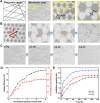Self-Assembled Viscoelastic Surfactant Micelles with pH-Responsive Behavior: A New Fracturing-Displacement Integrated Working Fluid for Unconventional Reservoirs
- PMID: 38826515
- PMCID: PMC11137712
- DOI: 10.1021/acsomega.4c00459
Self-Assembled Viscoelastic Surfactant Micelles with pH-Responsive Behavior: A New Fracturing-Displacement Integrated Working Fluid for Unconventional Reservoirs
Abstract
The integrated fracturing and oil recovery strategy is a new paradigm for achieving sustainable and cost-effective development of unconventional reservoirs. However, a single type of working fluid cannot simultaneously meet the different needs of fracturing and oil displacement processes. Here, we develop a pH-responsive fracturing-displacement integrated working fluid based on the self-assembled micelles of N,N-dimethyl oleoamine propylamine (DOAPA) and succinic acid (SA). By adjusting the pH of the working fluid, the DOAPA and SA molecules can be switched repeatedly between highly viscoelastic wormlike micelles and aqueous low-viscosity spherical micelles. The zero-shear viscosity of the working fluid enriched the wormlike micelles can reach more than 93,100 mPa·s, showing excellent viscoelasticity and sand-carrying properties. The working fluid is easy to gel-break when it encounters oil, generating a low-viscosity liquid without residue. In addition, the system has strong interfacial activity, which can greatly reduce the oil-water interfacial tension to form emulsions and can achieve reversible demulsification and re-emulsification by adjusting pH. Through the designed and fabricated microfluidic chip, it can be visualized that under the synergistic effect of viscoelasticity and interfacial activity DOAPA/SA can effectively expand the swept volume of tight fractured formations, promote pore wetting reversal and crude oil emulsification, and improve the displacement efficiency. The DOAPA/SA meets the design requirements of the fracturing-displacement integrated working fluids and provides a novel method and idea for constructing the integrated working fluids suitable for fracturing and displacement in unconventional reservoirs.
© 2024 The Authors. Published by American Chemical Society.
Conflict of interest statement
The authors declare no competing financial interest.
Figures







Similar articles
-
Experimental Investigation and Performance Evaluation of Modified Viscoelastic Surfactant (VES) as a New Thickening Fracturing Fluid.Polymers (Basel). 2020 Jun 30;12(7):1470. doi: 10.3390/polym12071470. Polymers (Basel). 2020. PMID: 32629958 Free PMC article.
-
Influence Factors of Multifunctional Viscous Drag Reducers and Their Optimization for Unconventional Oil and Gas Reservoirs.ACS Omega. 2021 Nov 15;6(47):32101-32108. doi: 10.1021/acsomega.1c04869. eCollection 2021 Nov 30. ACS Omega. 2021. PMID: 34870031 Free PMC article.
-
Study of a Novel Gemini Viscoelastic Surfactant with High Performance in Clean Fracturing Fluid Application.Polymers (Basel). 2018 Nov 1;10(11):1215. doi: 10.3390/polym10111215. Polymers (Basel). 2018. PMID: 30961140 Free PMC article.
-
A Review of Weak Gel Fracturing Fluids for Deep Shale Gas Reservoirs.Gels. 2024 May 18;10(5):345. doi: 10.3390/gels10050345. Gels. 2024. PMID: 38786262 Free PMC article. Review.
-
Novel Trends in the Development of Surfactant-Based Hydraulic Fracturing Fluids: A Review.Gels. 2021 Dec 12;7(4):258. doi: 10.3390/gels7040258. Gels. 2021. PMID: 34940318 Free PMC article. Review.
Cited by
-
Development and performance evaluation of multi-functional slickwater fracturing fluid system for shale reservoirs.Sci Rep. 2025 May 21;15(1):17637. doi: 10.1038/s41598-025-02520-y. Sci Rep. 2025. PMID: 40399327 Free PMC article.
References
-
- Muther T.; Qureshi H. A.; Syed F. I.; Aziz H.; Siyal A.; Dahaghi A. K.; Negahban S. Unconventional hydrocarbon resources: geological statistics, petrophysical characterization, and field development strategies. Journal of Petroleum Exploration and Production Technology 2022, 12 (6), 1463–1488. 10.1007/s13202-021-01404-x. - DOI
-
- Jia C.; Zheng M.; Zhang Y. Unconventional hydrocarbon resources in China and the prospect of exploration and development. PETROLEUM EXPLORATION AND DEVELOPMENT 2012, 39 (2), 139–146. 10.1016/S1876-3804(12)60026-3. - DOI
-
- Chong Z. R.; Yang S. H. B.; Babu P.; Linga P.; Li X.-S. Review of natural gas hydrates as an energy resource: Prospects and challenges. APPLIED ENERGY 2016, 162, 1633–1652. 10.1016/j.apenergy.2014.12.061. - DOI
-
- Jarvie D. M.; Hill R. J.; Ruble T. E.; Pollastro R. M. Unconventional shale-gas systems: The Mississippian Barnett Shale of north-central Texas as one model for thermogenic shale-gas assessment. AAPG BULLETIN 2007, 91 (4), 475–499. 10.1306/12190606068. - DOI
-
- Barati R.; Liang J.-T. A review of fracturing fluid systems used for hydraulic fracturing of oil and gas wells. J. Appl. Polym. Sci. 2014, 131 (16), 40735.10.1002/app.40735. - DOI
LinkOut - more resources
Full Text Sources
